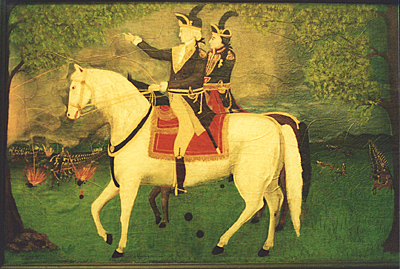
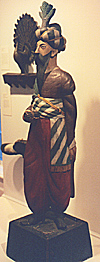 We retraced our steps down Gloucester Street and headed to the Abby Aldrich Rockefeller Folk Museum. Fortuitously, its special exhibit was coverlets, and since my wife stitches, quilts, and needlepoints, this was an excellent place to visit.
We retraced our steps down Gloucester Street and headed to the Abby Aldrich Rockefeller Folk Museum. Fortuitously, its special exhibit was coverlets, and since my wife stitches, quilts, and needlepoints, this was an excellent place to visit.
Right: George Washington at some battle.
Left: Cigar-store Ottoman.
The Colonial Williamsburg day pass covered entrance to the museum, which started in the 1920s and completed a major expansion in 1992, and now contains over 4,000 items.
The museum houses Americana from the 19th and 20th centuries. It's an eclectic collection of paintings, sculptures, needlework, furniture, and other folk "art" of various quality and appeal.
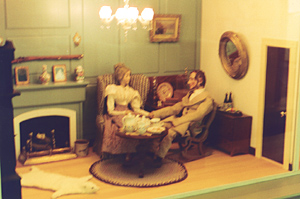
 The room-sized dollhouse was a wonder to behold. Even if you are not interested in dollhouses, you can appreciate the various efforts to make it as real as possible. Rooms follow rooms, paintings follow paintings, and other "stuff" works their way into your art consciousness. Some of it is good, some awful, and most fall in between: eye of the beholder and all that.
The room-sized dollhouse was a wonder to behold. Even if you are not interested in dollhouses, you can appreciate the various efforts to make it as real as possible. Rooms follow rooms, paintings follow paintings, and other "stuff" works their way into your art consciousness. Some of it is good, some awful, and most fall in between: eye of the beholder and all that.
More Dollhouse photos (slow: 198K)
Upstairs is more of the same. There is an entire room taken out, plank by plank, from a now razed house. It features a complete painting scheme of the 19th century, complete with mural-like scenes and other touches that would decorate the inside of a well-to-do house of the period.
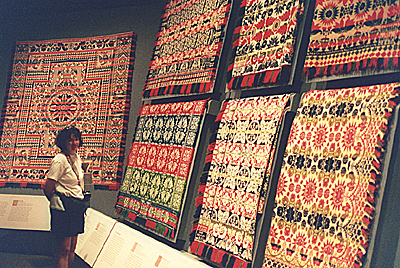 Downstairs were four areas with the special exhibits.
Downstairs were four areas with the special exhibits.
The first held a number of objects which seem to have no particular theme. Some tobacconists figures, weather vanes, and other stuff.
At left: Cigar Store Officer.
Quilt and Bedspread Photo (slow: 176K)
The second "L"-shaped room held the coverlets, and was much more impressive. Close to 50 19th century coverlets from the collection of Foster and Muriel McCarl were spread out along the walls and in the center, along with a variety of informational signs explaining the construction, type, and other details.
MagWeb.com VP Susan Lockwood, a noted stitcher, surveys the coverlets.
I liked some of the patterns, though at this point, I would have preferred a bench to sit on while my wife gloried in the details.
That's the thing about such exhibits. If you yourself pursue something, say, weaving a coverlet, you understand precisely what goes into it--time, effort, fabric, and so on. That's where an exhibit like this really gets appreciated--by those who have actually woven one. As for me, I liked some of the patterns.
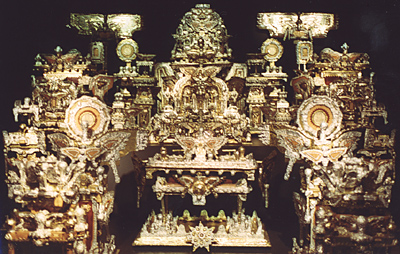 The third room had something out of the Twilight Zone. Some fellow thought he was a prophet to God and started his own sect. He did things like write down what God said in a code of some sort and so on, but the main thing he did, and what is in the museum, is create the Heavenly Throne of God--out of wood wrapped with aluminum foil and gold-colored foil.
The third room had something out of the Twilight Zone. Some fellow thought he was a prophet to God and started his own sect. He did things like write down what God said in a code of some sort and so on, but the main thing he did, and what is in the museum, is create the Heavenly Throne of God--out of wood wrapped with aluminum foil and gold-colored foil.
This photo does not do justice to the depth of this, er, creation. This is a 20' wide x 40' deep x 10' high or so aluminum foil extravaganza. You were not allowed to walk inside, although a second window on the right allowed another view of the rear section.
He built it in his garage and would show only a few special people. The setup had to be about 20 feet wide by 40 feet deep by 10 feet high. This was a lot of aluminium foil. And it is, undeniably, folk art. The artists is dead now, but his, and please, I don't wish ill on the dead, but his mania lives on. I guess when the Second Coming came, he wanted to have a spot for God to sit. There were other spots for other people, but I can't recall who. I guess one seat was reserved for him.
The last room contained wood carvings. Now, this fellow had talent. In the 1950s, this drifter would occasionally put down roots at a shop and carve away on planks 5, 10, and 20 feet long. The sheer patience to meticulouly carve leaves, trains, people, and farm scenes is amazing. Although I don't remember the name of the carver, this was truly the most impressive exhibit in the museum.
As we left the special exhibits area, we stopped in the gift shop, where my wife picked up a couple books on needlework.
More Colonial Williamsburg
- Introduction
Governor's Palace
Into Town: Shops
Abby Aldrich Rockefeller Folk Museum
Arms Magazine Area
Where to Stay, Eat, and Play
Back to List of Historic Sites
Back to Travel Master List
Back to MagWeb Master List of Magazines
© Copyright 2003 by Coalition Web, Inc.
This article appears in MagWeb (Magazine Web) on the Internet World Wide Web.
Other articles covering military history and related topics are available at http://www.magweb.com